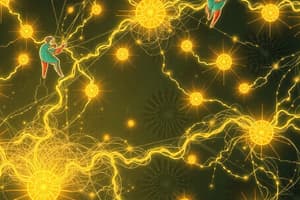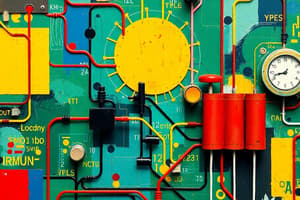Podcast
Questions and Answers
What is the definition of resistance?
What is the definition of resistance?
- Slows down the flow of electricity in a circuit (correct)
- Pushes electricity through a circuit
- A material that allows the flow of electricity
- The rate of flow of electricity through a circuit
What does voltage do?
What does voltage do?
- Slows down the flow of electricity
- Pushes electricity through a circuit (correct)
- Connects the parts of the circuit together
- Turns electricity on and off in a circuit
What is current?
What is current?
- The unit of electrical resistance
- A material that resists electrical flow
- A measure of electrical potential
- The rate of flow of electricity through a circuit (correct)
What is a conductor?
What is a conductor?
What is an insulator?
What is an insulator?
What does a schematic diagram represent?
What does a schematic diagram represent?
An open circuit allows electricity to flow.
An open circuit allows electricity to flow.
A closed circuit permits the flow of electricity.
A closed circuit permits the flow of electricity.
What does a battery do?
What does a battery do?
What is the function of wires in a circuit?
What is the function of wires in a circuit?
What does a switch do in a circuit?
What does a switch do in a circuit?
What is the use of a light bulb in a circuit?
What is the use of a light bulb in a circuit?
What is a resistor?
What is a resistor?
What unit is electrical current measured in?
What unit is electrical current measured in?
What unit is voltage measured in?
What unit is voltage measured in?
What unit is electrical resistance measured in?
What unit is electrical resistance measured in?
What symbol represents current in Ohm's formula?
What symbol represents current in Ohm's formula?
Like charges ___; unlike charges ___.
Like charges ___; unlike charges ___.
What is electrical force measured in?
What is electrical force measured in?
What is electric charge measured in?
What is electric charge measured in?
What is induction?
What is induction?
What is polarization?
What is polarization?
How were charges transferred in demonstrations like the Van de Graaff?
How were charges transferred in demonstrations like the Van de Graaff?
Why can a charged balloon stick to the wall?
Why can a charged balloon stick to the wall?
What is grounding?
What is grounding?
How does an electroscope work?
How does an electroscope work?
What does it mean when the leaves of an electroscope diverge?
What does it mean when the leaves of an electroscope diverge?
What is an electric field?
What is an electric field?
Electric field lines flow ___ positive charges and ___ negative charges.
Electric field lines flow ___ positive charges and ___ negative charges.
Coulomb's law states that two charges exert a ___ on one another that is ___ proportional to the product of the magnitudes of the charges and ___ proportional to the square of the distance between their centers.
Coulomb's law states that two charges exert a ___ on one another that is ___ proportional to the product of the magnitudes of the charges and ___ proportional to the square of the distance between their centers.
What happens to the electric force between two charged particles when the charge of one of the particles doubles?
What happens to the electric force between two charged particles when the charge of one of the particles doubles?
What happens to the electric force if both charges are doubled?
What happens to the electric force if both charges are doubled?
What happens to the electric force when the distance between two charged particles doubles?
What happens to the electric force when the distance between two charged particles doubles?
What happens to the electric force when the distance is cut in half?
What happens to the electric force when the distance is cut in half?
What is electrical current made of?
What is electrical current made of?
Ohm's law states, 'For a given resistor at a particular temperature, the current is ___ proportional to the applied voltage.'
Ohm's law states, 'For a given resistor at a particular temperature, the current is ___ proportional to the applied voltage.'
According to Ohm's law, resistance and current are ___ proportional.
According to Ohm's law, resistance and current are ___ proportional.
According to Ohm's law, voltage and current are ___ proportional.
According to Ohm's law, voltage and current are ___ proportional.
If the voltage is constant, as resistance increases, what happens to the current?
If the voltage is constant, as resistance increases, what happens to the current?
If the voltage is constant, as resistance decreases, what happens to the current?
If the voltage is constant, as resistance decreases, what happens to the current?
What is an electric circuit?
What is an electric circuit?
What is needed to make a simple electric circuit?
What is needed to make a simple electric circuit?
What does the resistance in a wire depend on?
What does the resistance in a wire depend on?
What determines electrical power?
What determines electrical power?
Flashcards are hidden until you start studying
Study Notes
Key Concepts of Current Electricity
- Resistance: Opposes and slows down electric current flow in a circuit.
- Voltage: The driving force that pushes electric current through a circuit.
- Current: Measured in amperes (A), it indicates the rate of flow of electricity.
Circuit Components
- Conductor: Materials, such as metals, that facilitate the flow of electric current.
- Insulator: Materials that restrict or prevent electric current flow, e.g., rubber or glass.
- Battery: Supplies voltage to push current through a circuit.
- Wires: Connect circuit components, allowing current to travel between elements.
- Switch: Controls the flow of electricity by opening (off) or closing (on) a circuit.
- Light Bulb: Converts electrical energy into radiant energy (light).
Circuit Types
- Open Circuit: Contains a break where current cannot flow.
- Closed Circuit: Completed loop, allowing electricity to flow continuously.
Measurement Units
- Amperes (A): Unit for measuring electrical current.
- Volts (V): Unit for measuring electrical potential or voltage.
- Ohms (Ω): Unit for measuring electrical resistance.
Electrical Principles
- Ohm's Law: Defines the relationship where current is directly proportional to voltage and inversely proportional to resistance.
- Electric Charge: Measured in coulombs; represents the quantity of electricity.
- Induction: Charge transfer occurs by bringing a charged object close to another, rearranging surface charges.
- Polarization: Internal charge rearrangement creating positive and negative sides within an object.
Charge Interactions
- Like charges repel each other, while unlike charges attract.
- An electric field influences the behavior of charges in its vicinity, with lines indicating direction from positive to negative charges.
Coulomb’s Law
- States that electric charges exert forces directly proportional to their product and inversely proportional to the distance squared between them.
Observations and Concepts
- An electroscope detects electric charges and operates using a metal framework insulated from the ground.
- Grounding involves creating a pathway for excess charge to dissipate into the earth.
- Electric force changes when either the charge or distance between two charged particles is altered.
Factors Influencing Resistance
- Resistance in a wire depends on its thickness, length, and the material's conductivity.
Power in Electrical Circuits
- Electrical power is a product of voltage and current, inversely tied to resistance according to Ohm’s Law.
Essential Elements for Circuit Construction
- A simple electric circuit requires a voltage source, connecting wires, and an electrical load.
Studying That Suits You
Use AI to generate personalized quizzes and flashcards to suit your learning preferences.




